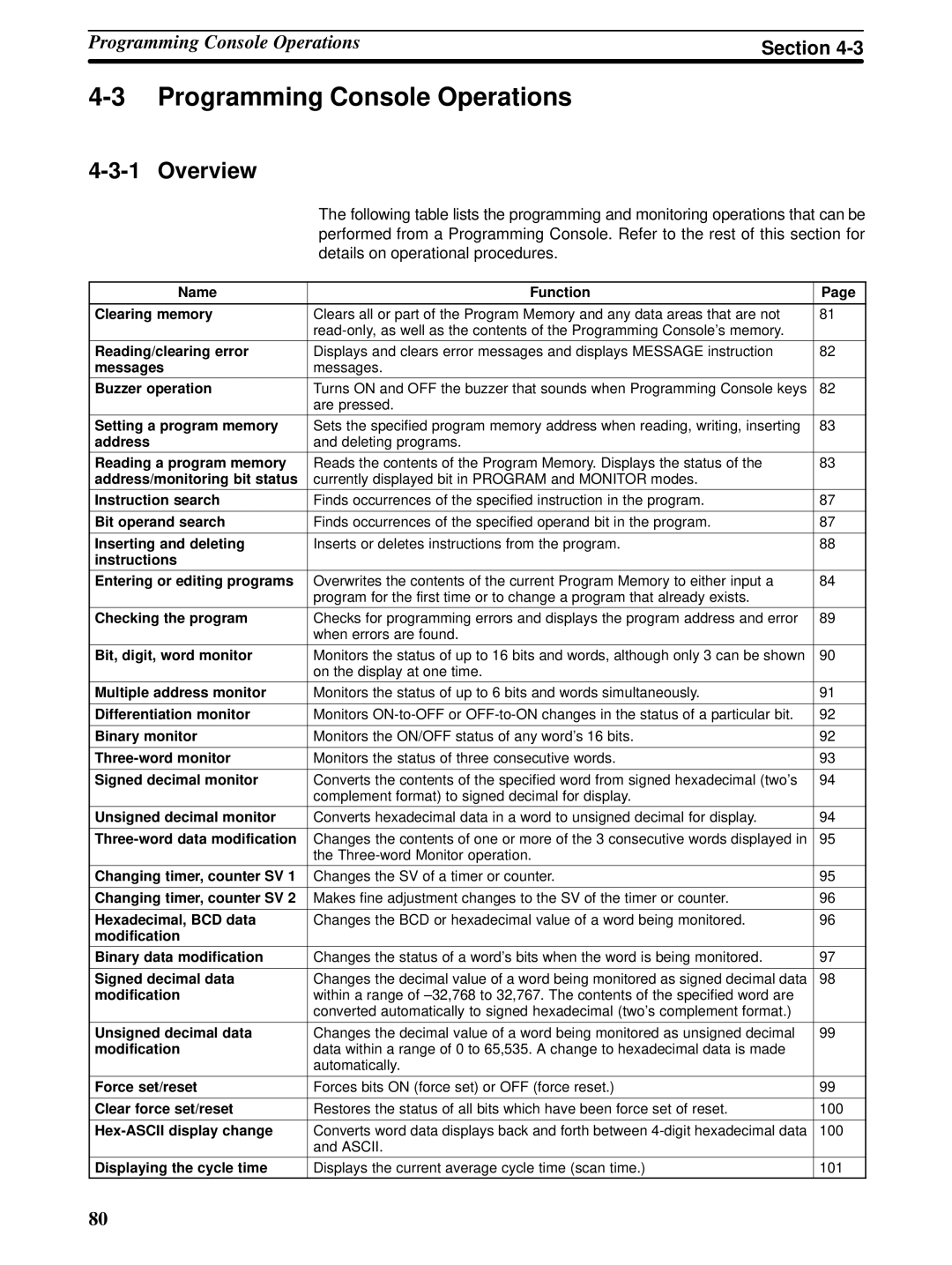Programming Console Operations | Section | |
|
|
|
4-3 Programming Console Operations
4-3-1 Overview
The following table lists the programming and monitoring operations that can be performed from a Programming Console. Refer to the rest of this section for details on operational procedures.
Name | Function | Page |
|
|
|
Clearing memory | Clears all or part of the Program Memory and any data areas that are not | 81 |
|
| |
|
|
|
Reading/clearing error | Displays and clears error messages and displays MESSAGE instruction | 82 |
messages | messages. |
|
Buzzer operation | Turns ON and OFF the buzzer that sounds when Programming Console keys | 82 |
| are pressed. |
|
Setting a program memory | Sets the specified program memory address when reading, writing, inserting | 83 |
address | and deleting programs. |
|
Reading a program memory | Reads the contents of the Program Memory. Displays the status of the | 83 |
address/monitoring bit status | currently displayed bit in PROGRAM and MONITOR modes. |
|
Instruction search | Finds occurrences of the specified instruction in the program. | 87 |
|
|
|
Bit operand search | Finds occurrences of the specified operand bit in the program. | 87 |
|
|
|
Inserting and deleting | Inserts or deletes instructions from the program. | 88 |
instructions |
|
|
|
|
|
Entering or editing programs | Overwrites the contents of the current Program Memory to either input a | 84 |
| program for the first time or to change a program that already exists. |
|
|
|
|
Checking the program | Checks for programming errors and displays the program address and error | 89 |
| when errors are found. |
|
|
|
|
Bit, digit, word monitor | Monitors the status of up to 16 bits and words, although only 3 can be shown | 90 |
| on the display at one time. |
|
|
|
|
Multiple address monitor | Monitors the status of up to 6 bits and words simultaneously. | 91 |
|
|
|
Differentiation monitor | Monitors | 92 |
|
|
|
Binary monitor | Monitors the ON/OFF status of any word’s 16 bits. | 92 |
|
|
|
Monitors the status of three consecutive words. | 93 | |
|
|
|
Signed decimal monitor | Converts the contents of the specified word from signed hexadecimal (two’s | 94 |
| complement format) to signed decimal for display. |
|
|
|
|
Unsigned decimal monitor | Converts hexadecimal data in a word to unsigned decimal for display. | 94 |
|
|
|
| Changes the contents of one or more of the 3 consecutive words displayed in | 95 |
| the |
|
Changing timer, counter SV 1 | Changes the SV of a timer or counter. | 95 |
|
|
|
Changing timer, counter SV 2 | Makes fine adjustment changes to the SV of the timer or counter. | 96 |
|
|
|
Hexadecimal, BCD data | Changes the BCD or hexadecimal value of a word being monitored. | 96 |
modification |
|
|
|
|
|
Binary data modification | Changes the status of a word’s bits when the word is being monitored. | 97 |
|
|
|
Signed decimal data | Changes the decimal value of a word being monitored as signed decimal data | 98 |
modification | within a range of |
|
| converted automatically to signed hexadecimal (two’s complement format.) |
|
|
|
|
Unsigned decimal data | Changes the decimal value of a word being monitored as unsigned decimal | 99 |
modification | data within a range of 0 to 65,535. A change to hexadecimal data is made |
|
| automatically. |
|
|
|
|
Force set/reset | Forces bits ON (force set) or OFF (force reset.) | 99 |
|
|
|
Clear force set/reset | Restores the status of all bits which have been force set of reset. | 100 |
|
|
|
Converts word data displays back and forth between | 100 | |
| and ASCII. |
|
|
|
|
Displaying the cycle time | Displays the current average cycle time (scan time.) | 101 |
80
